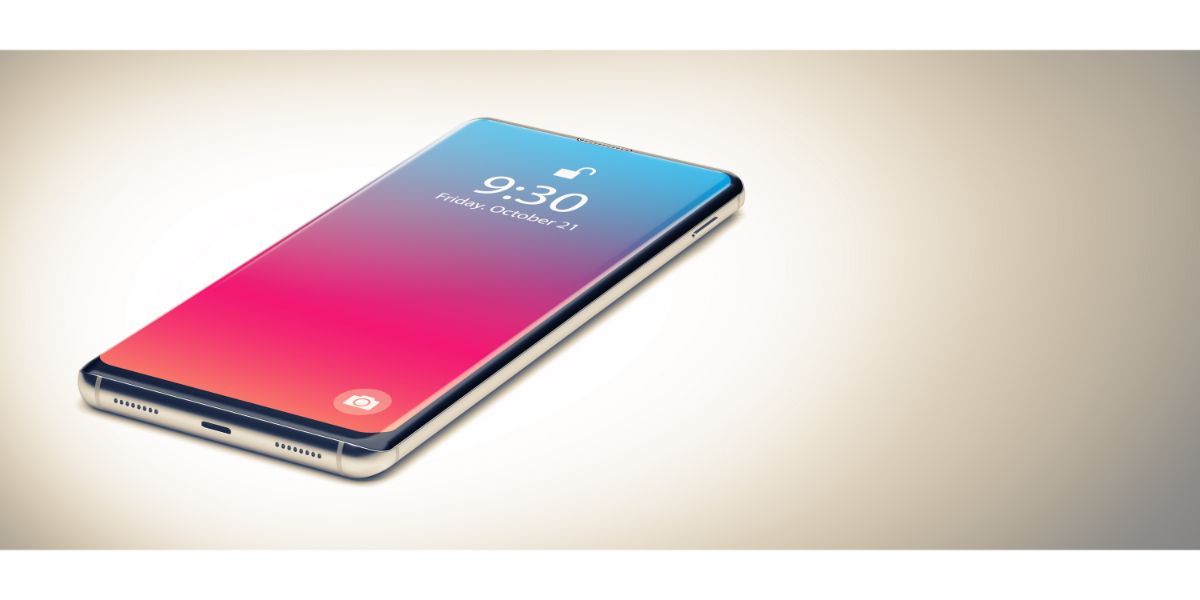Disclaimer: This post may contain affiliate links, meaning we get a small commission if you make a purchase through our links, at no cost to you. For more information, please visit our Disclaimer Page.
These days, finding a reliable phone with a screen smaller than 5.5 inches (13.97 cm) will take a lot of work. Ten years ago, a phone’s 5.5-inch (13.97 cm) screen was considered massive. This change in how phones look begs the question of why modern phones are so big.
Table of Contents
Modern Phones’ Screen Size Explained
In 2012, Samsung announced a revolutionary product — the Samsung Galaxy Note. It had a then massive 5.3-inch (13.46 cm) display, and people referred to it as a phablet (phone and tablet).
The Samsung Galaxy Note was so huge that critics doubted whether people would even buy it. Some even said it wouldn’t have a future in the smartphone market.
Back then, people wanted a phone that they could use single-handedly. Being the lightest and thinnest phone is one of the main goals for phone manufacturers. After all, smartphones are for portability and ease of use, right?
Fast forward nine years, Apple released iPhone 13, and the smallest in its line-up is the iPhone 13 Mini, which featured a 5.4-inch (13.72 cm) display.
The iPhone 13 Mini is bigger than what many considered too big for a phone nine years ago, yet Apple still calls it mini. However, people didn’t buy the idea of a “mini” phone, and Apple removed the ‘mini release’ from its iPhone 14 line-up.
Of course, the designs of phones back then were a lot different.
The Samsung Galaxy Note had a 66.8% screen-to-body ratio, while the iPhone 13 mini had an 85.1% screen-to-body ratio. However, comparing the actual size for both units, a “phablet” in 2012 is not that big compared to a “mini” phone in 2021.
Here are the actual measurements for the Samsung Galaxy Note, iPhone 13 Mini, and for added comparison, Samsung Galaxy Note 20 Ultra:
| Samsung Galaxy Note (2012) | iPhone 13 Mini (2021) | Samsung Galaxy Note 20 Ultra (2020) | |
|---|---|---|---|
| Width | 83.1 mm (3.27 in) | 64.2 mm (2.53 in) | 77.2 mm (3.04 in) |
| Length | 146.8 mm (5.78 in) | 131.5 mm (5.18 in) | 164.8 mm (6.49 in) |
| Thickness | 9.7 mm (0.38 in) | 7.7 mm (0.30 in) | 8.1 mm (0.32 in) |
Looking at these phone sizes, we can say that the Galaxy Note is closer to iPhone 13 Mini than the Galaxy Note 20 Ultra. So, what happened between 2012 and 2021 that changed how we see smartphones?
There’s one word to explain why modern phones are so big and why manufacturers are pushing the limits of how big a smartphone can really get — competition.
Your smartphone’s screen is your point of interaction with the device. It’s what you use to do almost anything with your phone. It’s arguably the most significant part of the phone and the only one that average users can see to determine whether a phone is good or not.
Sure, average users can feel that a phone is faster and more responsive, but there’s no way for them to quantify it.
However, if you’ve been using a phone with a 5.5-inch (13.97 cm) IPS-LCD display and compare it with a phone with a 6.5-inch (16.51 cm) AMOLED display, the mammoth differences hit differently. You’ll know that it’s a much better phone, even without going through the specifications.
However, manufacturing a bigger phone to have a bigger screen isn’t the actual reason.
We’ve seen this with the iPhone 13 and the iPhone 13 Mini — the same display quality on different screen sizes didn’t affect the consumers’ decision to get one over the other. The features of these phones swayed buyers to pick the iPhone 13.
The screen size is simply an essential after-effect of all the improvements in smartphones that happened over the years. The features inside a phone are why modern phones are so big.
Let’s examine some of the main reasons why modern phones are so big:
Bigger and Better Camera
In the early days, a camera in a smartphone was already revolutionary. It allowed users to have two devices in one. However, smartphone cameras before were just an afterthought. Back then, a camera that could take decent photos was already good enough for most users.
We only had a mainstream camera-first smartphone when Samsung released the Galaxy S4 Zoom in 2013. That’s when manufacturers saw the demand for better, bigger cameras on a smartphone. They tried a lot of different solutions, from software enhancements to hardware upgrades, to come up with the best camera possible for a smartphone year after year.
The result was Samsung Galaxy S20 Ultra in 2020. It came with four cameras; 108 megapixels for the primary camera and 48 megapixels for the telephoto lens. These lenses dwarf the 16 megapixels of the Galaxy S4 Zoom in terms of capabilities and size, and it only took seven years to get there.
However, having four massive cameras in a phone has a caveat. It requires more space inside the phone. So Samsung needed to decide whether they would remove features or increase the size to accommodate the cameras in their new releases.
Fortunately, Samsung didn’t have to give up anything. They solved their problem by giving their customers something they’ll continue to appreciate for years — a bigger and better screen.
Better Heat Dissipation for Processors
Today’s budget smartphone ($150 to $300) has much more power than the IBM ® System/360 supercomputers that NASA used for the Apollo missions combined. We’ve come a long way in reducing the size of the processors we use for computers, together with the other components.
However, there’s one thing that computer parts still have to deal with, and it is also one factor that affects the size of a smartphone, heat dissipation.
Since manufacturers can’t put computer fans inside smartphones, they intentionally make them bigger to help distribute heat and reduce the long-term effect of heating components.
Phones are very compact computers with all parts tightly arranged close to each other. Most of these parts produce heat, but the biggest contributors are the processors. Phone manufacturers need to make their phones bigger because the more power it has, the more heat it produces, which requires better cooling solutions.
Some manufacturers even include liquid cooling technology inside the phones to keep them cool and minimize the effect of everyday use. Aside from the typical space required for proper heat dissipation, other technologies like liquid cooling need additional space inside the phone.
Given that the phones we’re using are already maxed out in terms of the space for their parts, the only option is to increase the phone’s size to create more space for cooling features. It can be by making the phone larger or thicker, but it will most definitely increase its size.
Bigger Battery Capacity
Most will lean towards a bigger battery capacity if we ask people what they’d prefer between a smaller phone they can comfortably use with one hand or a bigger one.
Apple proved this when they released the Apple Store MagSafe Battery Pack (available on Amazon.com) for iPhone 12, 13, and 14. Many people didn’t mind using a bigger iPhone (or a battery bump, to be exact) as long as they get longer battery life.
However, this option isn’t available to most smartphone users as they must use power banks. Despite all the power bank improvements we’ve had the past year, there’s still a clear need for bigger phone batteries.
Large batteries have greater capacities compared to their smaller counterparts. And since smartphones have several uses, they need large-capacity batteries to support their functionality.
If you’ve been using a phone for more than two years, you’ll notice that you’re charging it more often than usual. Aside from the expected deterioration in its battery capacity over the years, a bigger factor affecting a smartphone’s battery life is its performance.
As smartphones get more powerful, they require larger batteries — they just go hand-in-hand. If you’re charging your phone more often today than two years ago, it’s not just because of your battery’s health but also because of the apps you have today.
Apps and operating systems update regularly, and the ones you had two years ago require much more processing power today than when you first got your phone. It may still be capable of running the apps, but the battery (2 years ago) can’t keep up with the demand.
The only way to solve this is to have bigger batteries right from the start. Doing this will make smartphones more future-proof in terms of battery capacity. However, they can only have a bigger battery by increasing the phone’s size.
Additional Features
One thing that makes smartphones exciting is the “latest and newest” feature that a manufacturer will announce for their next phone release. Doing this can be a massive challenge because the phones we have today can perform various functions.
We already have a lot inside our phones. Features like the following require space inside the smartphone:
- Antennas
- 5G connectivity
- Bluetooth
- NFC
- GPS
- Speakers
- Microphone
- Fingerprint sensor
- Storage
- RAM
If a manufacturer wants to add another feature inside a smartphone (which is what they need to do to grab market share), they need to make enough space for it. The only way for it to happen is to get rid of unnecessary features or make the phone bigger.
The more space there is inside the phone, the bigger the screen gets. This fact circles back to what we pointed out earlier – manufacturers aren’t building bigger phones to have bigger screens – it’s just an after-effect of integrating new features inside the phone.
Competition for Market Share
As we increasingly rely on smartphones for our daily activities, the features we need from them also change. In the past, consumers wanted the lightest and thinnest smartphones. However, as the market matures, consumers’ preferences also mature.
For years, Apple focused on building the thinnest and lightest iPhone ever. However, when they released the iPhone X, they stopped focusing on making it thinner and lighter. You won’t even hear those words in their keynotes anymore. Instead, they kept increasing their phones’ size to improve their performance and features.
All of these were a result of the ever-increasing competition for market share. The change in the size of modern phones made something very clear; consumers don’t mind using larger phones as long as they get better features.
It’s a win-win for both the consumers and manufacturers because it gave the manufacturers the greenlight to not focus on size but on the features their phones can provide. It removed all the obstacles preventing manufacturers from coming up with their best design.
The biggest challenge for phone manufacturers in the past was making their phones smaller so that people could perform one-handed operations on them. Nowadays, we’re getting more screen real estate because of our phones’ sheer size and functionality.
It’s all because manufacturers are trying to compete to give consumers the best performance and features from a smartphone.
Competition in the industry pushed the boundaries of what a phone can do and how it should look. Fierce competition forces manufacturers to come up with the best phones they can year after year, which empowers all consumers. We get more capable phones than ever, and we also have a wide range of smartphones to choose from.
Today, we can have the best of the best in smartphones (the flagship models of top manufacturers) or the cheapest yet capable all-rounder phone. It’s easier for consumers to pick the one they need, and they’re sure to get great value from it.
As companies continue to push the boundaries of what smartphones can do, we, as consumers, continue to get better, exciting phones.
Manufacturers can keep increasing the size of their phone releases and fold them in half (foldable phones) to let people use them as they would with normal phones. They can also make their footprint smaller but retain all the features we expect from smartphones.
With all of these new emerging technologies, who knows how big smartphones will be in a few years?
Conclusion
Modern phones are so big because manufacturers need to keep up with the features coming from their competitors or give up market share. Competition pushes the boundaries of smartphones and redefines their roles in our day-to-day lives.



